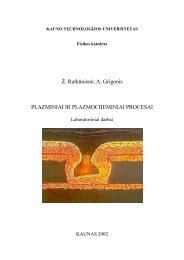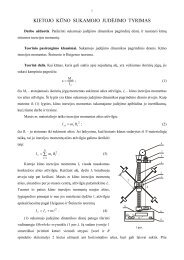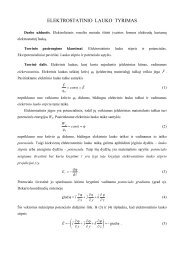PROCEEDINGS OF THE 7 INTERNATIONAL ... - Fizika
PROCEEDINGS OF THE 7 INTERNATIONAL ... - Fizika
PROCEEDINGS OF THE 7 INTERNATIONAL ... - Fizika
You also want an ePaper? Increase the reach of your titles
YUMPU automatically turns print PDFs into web optimized ePapers that Google loves.
MEDICAL PHYSICS IN <strong>THE</strong> BALTIC STATES 7 (2009)<br />
Proceedings of International Conference “Medical Physics 2009”<br />
8 - 10 October 2009, Kaunas, Lithuania<br />
APPLICATION <strong>OF</strong> NEUTRONS IN RADIO<strong>THE</strong>RAPY<br />
Gediminas ADLYS<br />
Kaunas University of Technology<br />
Abstract: An overview of neutron application for medical purposes from technological and physical point of view is<br />
presented in this article. It discusses the features of fast neutron therapy, neutron capture therapy and production of<br />
radionuclides by means of neutron activation and analyzes the requirements for neutron beams which are produced<br />
using different sources (nuclear reactors, accelerator driven systems neutron spallation sources).<br />
Keywords: neutron therapy, neutron sources, reactors, spallation sources<br />
1. Introduction<br />
Advance of science and technology continually find its<br />
place in medicine practice. Soon after X- rays discovery<br />
it was used for diagnostics and therapy and it continues<br />
until now. Improvements in radiotherapy results were<br />
noted with each technological advance. The field of<br />
radiation therapy began to grow after discovery of the<br />
radioactive elements polonium and radium. Radium was<br />
used until the cobalt and caesium teletherapy machines<br />
came into use. Nowadays, these units are being replaced<br />
by linear accelerators, working without radioactive<br />
sources, which makes them safer in the radiological<br />
point of view.<br />
With invention of computed tomography threedimensional<br />
planning became a possibility. It allows<br />
more accurate determination of the dose distribution<br />
using images of the patient’s anatomy.<br />
Construction of superconducting magnets and progress<br />
in cryogenic technique was applied developing nuclear<br />
magnetic resonance equipment for new imaging<br />
modalities. Advance in nuclear and particle physics<br />
technologies was basis for the positron emission<br />
tomography.<br />
The development of high power compact accelerators<br />
such as radiofrequency quadrupole linacs or cyclotrons<br />
creates the possibility to use neutron related techniques<br />
in medicine at reasonable cost. In proton accelerators<br />
accelerated protons could be used for proton therapy or<br />
for the bombardment of the proper target, which<br />
releases neutrons of sufficient energy to treat tumors at<br />
the modest tissue depths.<br />
Additionally, research nuclear reactors are used as<br />
neutron sources for producing radionuclides for<br />
medicine and for direct neutron therapy as a part of<br />
radiation therapy.<br />
Recently attention of radiotherapists is paid to the new<br />
developing branch of nuclear physics and technology –<br />
nuclear spallation neutron sources.<br />
86<br />
2. The place of neutrons in radiotherapy<br />
Radiation therapy is the medical use of ionizing<br />
radiation primarily in the treatment of malignant tumor.<br />
The biological response of a cancer cells to ionizing<br />
radiation is described by its radiosensitivity. The types<br />
of cancer are classified as “radioresistant”; if tumors do<br />
not respond well to low LET radiation [1]. Highly<br />
sensitive cancer cells are rapidly killed by modest doses<br />
of radiation while radioresistant cancer cells require<br />
much higher doses for radical cure than may be safe in<br />
hospital practice. The majority of epithelial cancers are<br />
only moderately radiosensitive, which require 60-70 Gy<br />
dose of radiation to achieve a radical cure.<br />
Radiation therapy of cancer is based upon the basic<br />
effect of ionizing radiation to destroy the ability of cells<br />
to divide and grow by damaging their DNA strands. The<br />
damage is caused by a photon, electron, proton, neutron<br />
or ion beam. It is done directly or indirectly ionizing the<br />
atoms of the DNA chain. For photon, electron and<br />
proton beam the damage is caused as a result of atomic<br />
interactions. It entails primarily the ionization of water,<br />
forming free radicals, notably hydroxyl radicals, which<br />
then damage the DNA. With neutron radiation the<br />
damage is caused by nuclear interactions. Cells have<br />
mechanisms for repairing DNA damage. If radiation is<br />
delivered in small sessions, normal tissue will have time<br />
to repair itself. Tumor cells typically lack effective<br />
repair mechanisms compared to most healthy cells and<br />
are generally less efficient in repair between fractions. It<br />
is one of reasons why the total dose is spread out over<br />
time or fractionated. Accumulating damage to the<br />
cancer cells causes them to die or reproduce more<br />
slowly.<br />
Photon, electron and proton radiation are called low<br />
linear-energy-transfer (LET) radiation. Neutrons are<br />
high LET radiation. If radioresistant tumor cell is<br />
damaged by low LET radiation it has a good possibility








